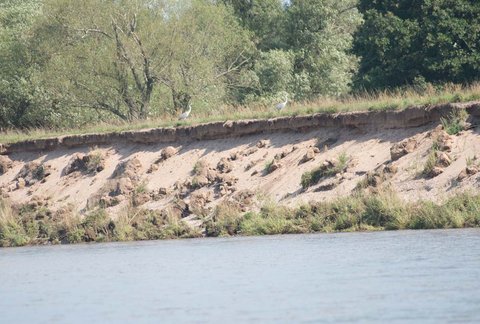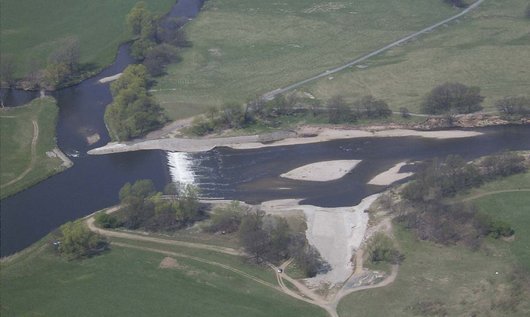For more than 300 years the Bobritz dam south of Eilenburg divides the river Mulde. It releases a stream, the Mühlgraben. Both surround the middle district like an island. Even though the mill wheels on the Mühlgraben are no longer running, the approximately two-meter-high filled stream still fulfills an important water management function. It was therefore renovated in 1998 and 1999 for eight million marks by the Free State of Saxony.
The Bobritz dam, which is also sometimes referred to as Kollauer weir, is still a popular destination for hikers and cyclists. They not only enjoy nature, but also look at the water management structure, which also has a fish pass.
History, function, renovation and goal
Even if the exact year is not known: In the 17th century, the dam must be made of wooden frames and natural stones. Part of the dammed up water has since flowed into the mill race. In the 20s of the 20th century, the building was rebuilt into a solid weir.
After that, decades passed without significant repair or remedial measures being taken. At the end of the 1990s, the approximately 90-meter-wide weir was therefore in poor structural condition. On the side of Kollau (Wurzen), the first consequences of the partially permeable weir were already visible.
In 1998, therefore, the Landestalsperrenverwaltung Rötha initiated on behalf of the Free State of Saxony, the rehabilitation of the Bobritz dam.

Even today, the Bobritz dam influenc the water management conditions around Eilenburg. Without the weir, the Mühlgraben would be drained quickly. But especially the infiltration of the water along the Mühlgraben is important for the drinking water supply of the region.
In particular, the waterworks Wedelwitz, but also in Canitz and Thallwitz, benefit from it. In the absence of the approximately two-meter high precipitation level, before which the water accumulates, the river hydraulics would also change significantly. Today existing bridges and dams would get risk.
From Groitzsch were built a 500-meter-long construction road along the left bank of the Mulde in the direction of flow, as well as a makeshift bridge over the Mühlgraben in the area of the weir. Both had to be completely rebuilt afterwards. Nevertheless, this proved to be much cheaper than the approximately 3.5 kilometers long journey from the Muldestadt over the Bürgergarten. After completion of the site road, half of the approximately 90-meter-wide weir was first drained from the Eilenburg side half-way. The damaged components of the weir were removed. The reconstruction was done with natural stones and concrete pinning. The deep stilling basin underwater area remained preserved close to nature. After completion of this construction project on the Eilenburger side, the same work was then carried out on the side of the Kollau. The rehabilitation of the weir was carried out on behalf of the Free State of Saxony under the direction of the Landestalsperrenverwaltung Rötha. It cost nearly eight million marks.
There was great excitement during the construction work in November 1998. During the autumn flood, more water than ever before flowed into the mill race due to the construction work on the Bobritzer dam. From here it spilled in a small tidal wave over the Bürgergarten to the Mulde. At that time, the only paved road to the Bürgergarten collapsed over a length of almost 100 meters. An estimated 400 to 800 cubic meters of soil were washed away. A planned for high waterfall gravel dam to Mühlgraben could not be built by the builders. The water was faster than the flood information.
After completion of the renovation in 1999, the fish can now for the first time in centuries not only walk across the mill race, but also across the Mulde itself up the river. This is made possible by a so-called fish ladder built on the Kollauer side. The principle: The height difference of two meters is "climbed" over a distance of around 35 meters. As stairs there are several smaller pools.
The Bobritz dam (weir Kollau) is still a popular destination today, especially for hikers and cyclists. From Eilenburg it is best to reach it via the Bürgergarten on foot or by bicycle. From the Mühlgraben bridge at Tierpark (Pioneer Bridge) there is a sign posted, about 2.8 kilometers long Planet Trail. It leads through the park and the huge Bürgergarten. His final destination is the Bobritzer dam on the Eilenburger side. Here, a small seating group invites you to a picnic on the rushing Mulde.
The Kollauer side of the weir can also be reached on foot or by bicycle. Starting at the Kastanienallee, a cycle path leads to the Bobritzer dam on the Kollauer side. Here is also the fish ladder. From Thallwitz you can also drive up to almost to the Kollauer weir.





